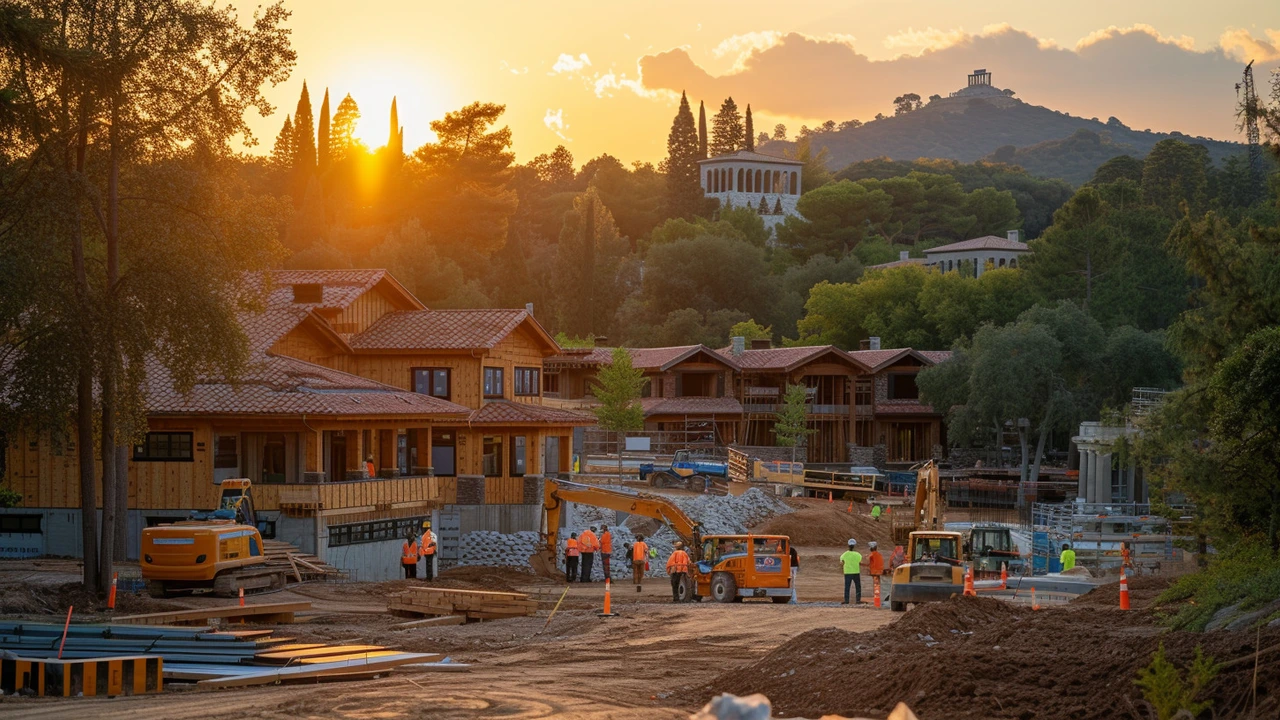Greek Revival Architecture: Where History Meets Style
 Aug, 8 2023
Aug, 8 2023
Understanding Greek Revival Architecture
Standing tall and proud in my living room is my Alaskan malamute, Luna, looking pointedly at the towering columns I excitedly purchased from an antique store. Like a stately column of the Parthenon, these pieces tell a story of an epoch defined by style, grandeur, and the incorporation of history into everyday buildings. I can't help but marvel at Greek Revival Architecture, and in today's blog post, we delve deep into this fascinating and ornate style of architecture.
Architectural dweebs like me just can't shake off the allure of Greek Revival Architecture. It's in my musings, conversations, and even my dreams. The other day, I was explaining to my parakeet, Rico, about Doric and Ionic orders, columns, entablature, you name it. Bonkers as it may seem, it's this insatiable curiosity that drives my love for Greek Revival Architecture. Eager? Let's dive right in.
The Prism of History & Philosophy
Being a child of the Enlightenment, Greek Revival Architecture isn't just about fancy facades and rich aesthetics. No, no! It's an embodiment of deep philosophical values and historical narratives. This architectural style is a testament to the ideals of democracy and freedom birthed by ancient Greece. It's fascinating how each beam, column, and ornamentation symbolises a society's noble aspirations.
Back in those days, it wasn't just about style or glamour. It was about imbibing and manifesting higher ideals into living spaces. It reflected the societal norms, values, and attitudes of the era. So every time I look at my newly acquired Greek Revival columns, I see a slice of history steeped in philosophy and gallantry. And yes, they make great conversation starters too!
Introducing The Greek Orders
Ever seen those intricate columns with fancy tops? Yep, those are the quintessential Greek Orders. They are the Doric, the Ionic, and the Corinthian. Each different, each unique, and each resplendent in its beauty and complexity. The Doric Order, with its proletarian style, stands ground, symbolising strength and stability. It is perhaps the simplest of the lot yet majestic in its simplicity.
On the other hand, the Ionic Order, with its signature scrolling volutes, seems almost poetic. It's believed that these intricate curls were inspired by the natural curls of a woman's hair. Interesting, isn't it? Then there is the Corinthian Order, the diva of the Greek Orders. Identified by its glamorous, leafy design, it's the epitome of virtuosity and elegance.
Details, Details, and more Details
Aha! Now we come to my favorite part. The devil is indeed in the details, and Greek Revival Architecture is full of them! Every nook and corner, every line and curve, is a canvas for the artisan's imagination. While we’ve talked about columns, Greek Revival style also includes a particular kind of entablature unique to it.
The entablature comprises the cornice, frieze, and the architrave (fancy words!). These are complexes of horizontal structures that rest on the columns in Greek Revival Architecture buildings. If you snoop around a building styled in Greek Revival, you’ll notice the fine details engraved in these sections. Quite intriguing!
The Resurgence of Greek Revival Architecture
Here's an interesting fact: the Greek Revival architectural style made its famed comeback in the 18th and the 19th century. Go figure! This nifty 'Neo-classical' reintroduction saw the exportation of Hellenic forms beyond Europe into further parts of the world, including the United States. And I am utterly grateful for this resurgence. If not for it, I wouldn't have my beautiful Greek columns!
So why did this style make a comeback, you ask? Well, the story extends from a sense of nostalgia for the past to a renewed fascination for Greek philosophy and ideals. Each building crafted in this style stood (and stands) as a ode to ancient Greek contributions to democracy, art, and philosophy.
Greek Revival and American Democracy
Imagine my surprise when I discovered that the Greek Revival architectural style played a central role in projecting American democratic ideals. The newly-formed United States found an ally in this style, and it used Greek Revival architecture to visually and ideologically connect with the sanctity of democracy that Ancient Greece was known for. Thus, this architectural style became an emblem of the burgeoning democracy – call it madness, I call it architectural diplomacy!
Incorporating Greek Revival Style in Your Home
If you're like me and you're intrigued by this architectural style, you don't need to worry. No, you don't need to bring down your house and rebuild it (though Luna might enjoy a new playground). All it takes is some creative touches, sophisticated purchases, and maybe a little advice from Luna and Rico.
Think imposing columns, ornate sculptures, Doric or Ionic themed wallpapers, and everything that can add the grandeur of ancient Greece to your space. However, remember not to go overboard; otherwise, you might end up with a home that looks like a quirky museum! A little aesthetic balance never hurt anybody.
A Look into the Future
While trends evolve and architectural styles shift, my love for Greek Revival Architecture remains immutable. Who knows? Maybe in the future, embracing a minimalist Greek Revival style could be the next big thing in architectural design. Luna and Rico might have to get used to living in a Greek themed environment!
Until then, allow yourself to be mesmerized by its history, its ornate details, and its ability to stand as a symbol of democracy and freedom. For all the architecture aficionados out there, let's continue to celebrate and appreciate the grandeur and charm of Greek Revival Architecture. With a hint of nostalgia, a splash of style, and a heap of history, Greek Revival Architecture is truly where history meets style.